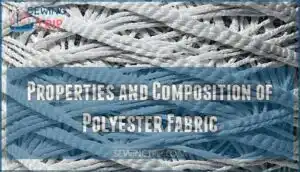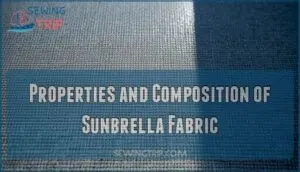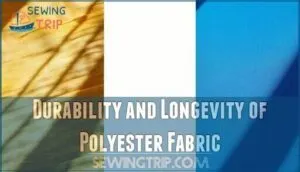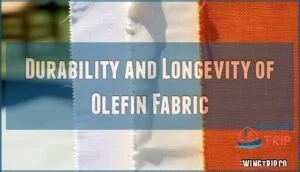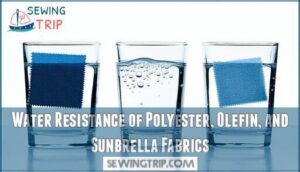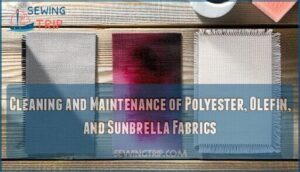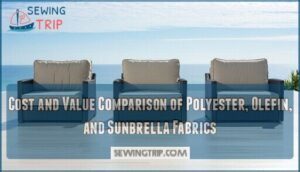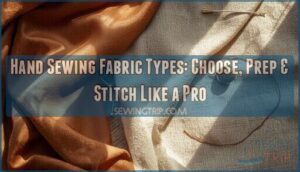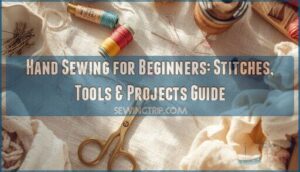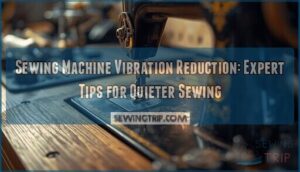This site is supported by our readers. We may earn a commission, at no cost to you, if you purchase through links.
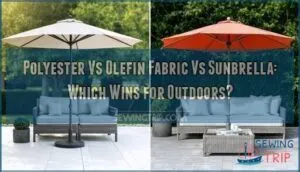 When weighing polyester vs olefin fabric vs Sunbrella for outdoor use, you’re comparing three distinct performance levels.
When weighing polyester vs olefin fabric vs Sunbrella for outdoor use, you’re comparing three distinct performance levels.
Polyester gives you the most bang for your buck with decent UV protection and easy cleaning, though it’ll fade faster than premium options.
Olefin acts like a moisture-repelling superhero, drying quickly and resisting stains, but feels less natural to touch.
Sunbrella reigns as the outdoor fabric champion, offering unbeatable fade resistance and breathability that outlasts cheaper alternatives by years.
Your choice boils down to budget versus longevity – think of it as choosing between a reliable sedan, sturdy truck, or luxury SUV.
Each fabric’s unique strengths shine in different outdoor scenarios.
Table Of Contents
- Key Takeaways
- Polyester Vs Olefin Vs Sunbrella
- Properties and Composition of Polyester Fabric
- Properties and Composition of Olefin Fabric
- Properties and Composition of Sunbrella Fabric
- Durability and Longevity of Polyester Fabric
- Durability and Longevity of Olefin Fabric
- Durability and Longevity of Sunbrella Fabric
- Water Resistance of Polyester, Olefin, and Sunbrella Fabrics
- Cleaning and Maintenance of Polyester, Olefin, and Sunbrella Fabrics
- Cost and Value Comparison of Polyester, Olefin, and Sunbrella Fabrics
- Frequently Asked Questions (FAQs)
- Conclusion
Key Takeaways
- Choose based on your budget and timeline – You’ll get 1-2 years from polyester ($10-15/yard), 2-4 years from olefin ($15-25/yard), or 5-10 years from Sunbrella ($25-40/yard), making Sunbrella the most cost-effective long-term choice at $4 per year.
- Sunbrella outperforms in durability and fade resistance – You’re getting solution-dyed acrylic that penetrates deep into fibers, delivering superior UV protection and breathability that outlasts both polyester and olefin by years in harsh outdoor conditions.
- Olefin offers the best moisture resistance – You’ll appreciate its natural water-repelling properties and quick-drying capabilities, plus it handles bleach and harsh chemicals better than polyester or Sunbrella for tough stain removal.
- Consider your climate when deciding – You’ll want polyester only for mild climates and temporary use, olefin for moderate conditions (but avoid extreme heat above 160°F), and Sunbrella for coastal areas or intense sun exposure where cheaper fabrics fail quickly.
Polyester Vs Olefin Vs Sunbrella
When you’re choosing outdoor fabric, you’re basically picking a long-term partner for your patio furniture.
Polyester fabric offers budget-friendly water resistance but fades quickly under intense sun.
Olefin fabric strikes a middle ground with decent stain resistance and moderate pricing, though it struggles in extreme heat.
Sunbrella fabric commands premium pricing but delivers superior durability and fade resistance that outlasts competitors by years.
Market trends show consumer preferences shifting toward solution-dyed options like Sunbrella, where color penetrates deep into fibers rather than sitting on the surface.
This fabric comparison reveals clear winners for different needs.
Considering the environmental impact, natural fibers offer a more sustainable alternative.
Environmental impact varies, with Sunbrella offering recycling programs while olefin produces minimal manufacturing waste.
Your fabric applications matter too.
Aesthetic appeal doesn’t mean much if your cushions fade after one season.
Choose polyester for mild climates and tight budgets, olefin for moderate use, or Sunbrella for long-term outdoor performance.
Properties and Composition of Polyester Fabric
Polyester fabric starts its journey from petroleum-based chemicals, creating synthetic fibers that lack natural breathability.
This synthetic nature means polyester won’t absorb moisture like cotton or wool, leaving you feeling sticky in humid conditions. The material’s weave structure and chemical resistance make it durable but create an artificial feel.
Here are polyester’s key characteristics:
- Synthetic Origins: Made entirely from petroleum-based chemicals
- Poor Moisture Absorption: Repels sweat instead of wicking it away
- Chemical Resistance: Withstands most stains and cleaning solutions
- Rigid Weave Structure: Maintains shape but feels stiff
- Synthetic Fibers: Create that plastic-like texture you’ll notice immediately
In contrast, rayon absorbs moisture, making it more comfortable in some situations.
Properties and Composition of Olefin Fabric
Olefin fabric starts with propylene gas that’s transformed into polypropylene plastic resin through synthetic composition processes.
This polypropylene origin gives olefin its standout stain resistance and naturally water-repelling qualities.
You’ll appreciate its recyclable nature, making it an eco-conscious choice for outdoor furniture.
However, olefin shows heat sensitivity compared to premium fabrics, which limits its durability in extreme sun exposure.
Eco-friendly production further enhances its appeal.
When comparing olefin vs sunbrella, olefin offers budget-friendly performance but won’t match Sunbrella’s longevity in harsh weather conditions, due to its lack of longevity.
Properties and Composition of Sunbrella Fabric
Sunbrella fabric stands apart with its 100% solution-dyed acrylic composition.
Unlike surface-dyed materials, the solution dyeing process saturates each acrylic fiber with color before weaving.
This creates superior brand recognition in outdoor performance applications.
The acrylic fibers maintain their structure under intense UV exposure, while the embedded pigments resist fading.
You’ll find Sunbrella’s fiber structure offers breathability without sacrificing water resistance.
This acrylic composition makes it the premium choice for awnings, marine covers, and patio furniture where long-term outdoor performance matters most.
It also boasts certifications for safety and low emissions.
Durability and Longevity of Polyester Fabric
The truth about polyester fabric reveals mixed durability results for outdoor use.
While polyester’s synthetic fibers resist tearing and stretching better than natural materials, extended sun exposure causes significant fade resistance problems and fiber degradation over time.
Polyester lifespan outdoors typically includes these performance factors:
- Strong abrasion resistance against daily wear and friction
- Excellent wrinkle recovery maintaining shape retention
- Poor UV protection leading to color fading
- Weather impact varies with fabric quality and treatments
- Chemical resistance to mildew and most stains
For durable fabric longevity, polyester works best with protective coatings. It’s also known for its resistance to shrinking.
Durability and Longevity of Olefin Fabric
Looking at olefin fabric’s track record, you’re getting a decent middle-ground option that won’t break the bank.
This durable fabric typically delivers 2-5 years of reliable outdoor performance, though it can’t quite match premium alternatives in extreme conditions.
Olefin’s fabric properties shine in several key areas. The synthetic material resists stains naturally and handles moderate weather well.
However, heat sensitivity becomes a real concern in scorching climates where temperatures soar above 160°F, potentially causing the fibers to melt or distort. Olefin is also known for its eco-friendly production process, which uses no water.
| Durability Factor | Olefin Performance |
|---|---|
| Abrasion Resistance | Excellent – resists wear |
| UV Fading Concerns | Moderate – some color loss |
| Weather Impact | Good in mild conditions |
| Heat Tolerance | Poor above 160°F |
| Olefin Lifespan | 2-5 years typical use |
The fabric longevity depends heavily on your climate. In moderate conditions with occasional use, olefin delivers solid value and maintains its shape even when wet.
Durability and Longevity of Sunbrella Fabric
How does Sunbrella fabric stand the test of time when Mother Nature throws her worst at your outdoor furniture? This solution-dyed acrylic powerhouse delivers exceptional fabric durability that puts other outdoor fabrics to shame.
When Mother Nature attacks your patio furniture, Sunbrella’s solution-dyed acrylic armor laughs in the face of sun, rain, and time.
You’ll get impressive lifespan expectations with Sunbrella’s unique construction. The color penetrates deep into each fiber during manufacturing, creating superior fade proofing that won’t wash out or bleach away. Independent testing confirms this UV resistant fabric maintains its strength and vibrant appearance far longer than competitors.
Here’s what makes Sunbrella fabric truly exceptional:
- UV Resistance – Built-in stabilizers protect against sun damage for years
- Extreme Temperatures – Performs consistently in scorching heat and freezing cold
- Abrasion Resistance – Withstands heavy use without showing wear patterns
- Fabric Water Resistance – Repels moisture while preventing mold and mildew growth
You can expect your Sunbrella investment to last 10 years under heavy outdoor use, delivering three times the longevity of standard outdoor fabric options. Fabrics like olefin provide superior water resistance, but Sunbrella balances many characteristics effectively.
Water Resistance of Polyester, Olefin, and Sunbrella Fabrics
Water protection varies dramatically between these outdoor fabrics.
Polyester fabric offers limited water resistance, allowing moisture to penetrate and promoting mold/mildew growth.
Olefin fabric provides better water-repellent properties with quicker fabric drying times than polyester.
Sunbrella fabric delivers superior fabric water resistance through its solution-dyed acrylic construction, though it’s water-resistant rather than waterproof.
For true waterproofing treatments, consider Sunbrella Rain or SeaMark versions.
Olefin’s production uses no water, making it an environmentally conscious choice.
Breathability comparison shows olefin leads, while seam water resistance depends on construction quality across all three materials, highlighting the importance of construction quality and water resistance.
Cleaning and Maintenance of Polyester, Olefin, and Sunbrella Fabrics
In the context of fabric maintenance, you’ll find significant differences between these three outdoor materials.
Polyester fabric requires gentle cleaning with mild detergent and water below 100 degrees, avoiding bleach entirely.
Olefin fabric offers easier care with soap-and-water spot cleaning and can handle harsh chemicals like bleach for stubborn stains.
Sunbrella fabric wins for convenience—it’s machine washable without fading thanks to solution-dyed fibers.
For mildew prevention and fabric protection, all three resist moisture well, but Sunbrella’s softer texture makes dirt removal simpler than textured alternatives.
For general washing, it’s best to use mild detergent and water for effective cleaning and to maintain the fabric’s quality.
Cost and Value Comparison of Polyester, Olefin, and Sunbrella Fabrics
Your wallet might cringe at Sunbrella fabric’s upfront cost, but it’s the smartest long-term investment for outdoor furniture.
While polyester fabric tempts with rock-bottom prices and olefin fabric offers middle-ground budget considerations, neither delivers Sunbrella’s decade-long performance.
Olefin is known for its resistance to moisture, making it a suitable choice for outdoor applications.
| Fabric | Price Range | Lifespan | Cost Per Year |
|---|---|---|---|
| Polyester | $10-15/yd | 1-2 years | $7.50 |
| Olefin | $15-25/yd | 2-4 years | $6.25 |
| Sunbrella | $25-40/yd | 5-10 years | $4.00 |
Climate impact drives replacement frequency—coastal conditions destroy cheaper fabrics faster, affecting resale value substantially, which is why choosing the right fabric is a critical decision for outdoor furniture.
Frequently Asked Questions (FAQs)
Is olefin fabric better than Sunbrella?
Sunbrella’s typically better than olefin for outdoor use.
You’ll get superior fade resistance, longer lifespan, and easier cleaning, though you’ll pay more upfront.
Olefin works if you’re budget-conscious and need decent performance.
What fabric is as good as Sunbrella?
Imagine this scenario: you’re hunting for Sunbrella’s match.
Solution-dyed acrylic fabrics from brands like Outdura and Glen Raven offer comparable fade resistance, durability, and weather protection.
These alternatives deliver similar performance at potentially lower costs, making them a viable option for those seeking comparable quality without the higher price tag.
Is olefin or polyester patio umbrella better?
You’ll find olefin patio umbrellas outperform polyester options.
Olefin resists fading better, dries faster, and handles outdoor conditions more effectively.
While polyester costs less initially, olefin’s superior durability makes it the smarter long-term choice.
What is the difference between Sunbrella and polyester?
Many think outdoor fabrics perform similarly, but they don’t. Sunbrella’s solution-dyed acrylic construction resists fading for 5-10 years, while polyester’s petroleum-based fibers fade quickly and retain odors, requiring frequent replacement.
Which fabric is easiest to sew or craft with?
You’ll find polyester easiest to sew with since it’s smooth, lightweight, and won’t dull your needles quickly.
Olefin cuts cleanly but can be slippery.
Sunbrella requires heavy-duty needles due to its thickness and solution-dyed construction.
How do the fabrics compare in terms of wrinkling and creasing?
You’ll find polyester resists wrinkles better than the other two fabrics. Olefin and Sunbrella tend to crease more easily, but they bounce back quickly when hung or stretched out properly.
Are any of the fabrics made from recycled materials?
Currently, these outdoor fabrics aren’t typically made from recycled materials.
However, you’ll find that Sunbrella has introduced recycling programs for their products, while olefin and polyester manufacturers are exploring sustainable options.
What are the best and worst applications for each fabric?
When push comes to shove, you’ll want Sunbrella for high-traffic outdoor furniture and marine use.
Olefin is suitable for budget-friendly patios, and polyester can be used for temporary indoor applications.
However, it’s crucial to avoid using polyester outdoors where it’ll fade quickly.
How breathable are the fabrics, and which would be coolest in hot weather?
Polyester traps heat and lacks breathability, making it the warmest option.
Olefin offers moderate airflow but retains some heat.
Sunbrella provides the best ventilation and stays coolest in hot weather due to its breathable acrylic fibers, making it a breathable choice.
Which fabric performs best in extreme cold weather?
Sunbrella handles extreme cold best among these three fabrics.
While all synthetic materials can become stiff in freezing temperatures, Sunbrella’s acrylic fibers maintain flexibility better than olefin or polyester in harsh winter conditions.
Conclusion
Research shows outdoor fabrics can last 15-20 years longer when you choose premium materials over basic options.
Your polyester vs olefin fabric vs Sunbrella decision ultimately depends on your priorities and budget.
Polyester offers affordability with moderate performance, olefin provides excellent moisture resistance at mid-range pricing, while Sunbrella delivers superior fade protection and longevity despite higher upfront costs.
Consider your climate, usage frequency, and replacement timeline when making this investment in your outdoor living space.
- https://thepopular.co.uk/differences-between-polyester-olefin-and-sunbrella-fabrics-for-outdoor-furniture/
- https://www.hineighbor.com/blogs/the-journal/sunbrella-vs-olefin-everything-you-need-to-know?srsltid=AfmBOorP7x3LvnpihizA7y4ou4xsTCrbwX7cJJakmd3D_qMKA5V9Oid6
- https://www.triadcushionfactory.com/blogs/triad-cushion-factory-blog/understanding-the-differences-in-outdoor-fabrics?srsltid=AfmBOoqb4UsLlyN_r1y7StGbtwZdhBliGPcPS-5JBU8bTiOVTpzgmlwB
- https://www.woodstockoutlet.com/blog/olefin-vs-sunbrella?srsltid=AfmBOor49OLham-GQ540iXXqbdYBeiX79WMgpQH4L1cpio_75nynqzmr
- https://madburyroad.com/blogs/outdoor-furniture-blog/sunbrella-vs-olefin-outdoor-fabric

